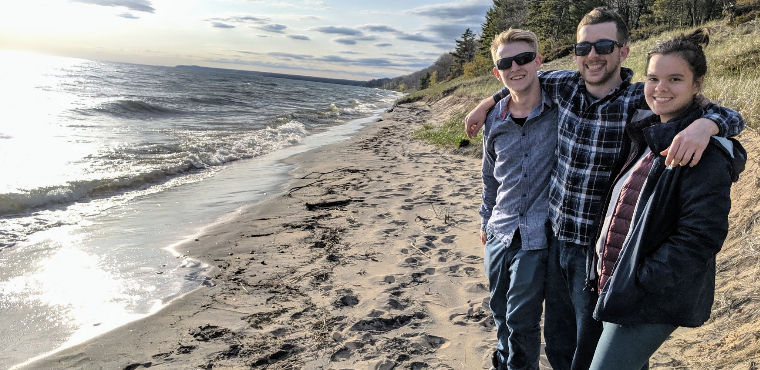Three UAFS geoscience graduates have demonstrated a wide range of research and disciplines in the program, and their graduate school plans and prestigious graduate fellowships, reflect the same diversity.
Samantha Barnett, Preston Liles, and Logan Pearson traveled with Dr. Maurice Testa, associate professor in the UAFS Physical Science department, to the Upper Peninsula of Michigan, where they identified a 400 million-year-old Silurian reef in the Hiawatha National Forest in the summer of 2019.
Testa and the three students took part in a joint venture between UAFS, the National Forest Service, and Shawnee State University at Portsmouth, Ohio. The investigators were initially charged with finding the prehistoric reef. But they found much more, according to Testa.
“Not only did we find the reef, we found an entire reef system composed of dozens of smaller reefs in the Hiawatha National Forest,” Testa said.
Liles collected high-resolution scans of the reef surfaces using a Gigapan camera, Testa said. Barnett and Pearson did a detailed analysis of the main reef and identified its marine fossils. The three worked with students from Shawnee State, conducting groundwater analysis and mapping ancient striations within the National Forest.
With graduation approaching, the three students have plans for the fall that take their studies in different directions.
Barnett, of Fort Smith, has accepted a fully funded position at Northern Arizona University to seek a master’s degree in Geosciences. She will be working in climate science and glaciology.
Liles, of Van Buren, has accepted a fully funded position at Mississippi State University. He will seek a master’s degree in Geospatial Science with a particular interest in remote sensing. He has also accepted an internship for this summer at Mississippi State’s Gulf Coast research center using an underwater drone to image the seafloor.
Pearson, of Greenwood, also has accepted a fully funded position at Mississippi State. He will be working toward a master’s degree in Geology with a concentration in Paleontology. He will be working on Cretaceous mosasaurs and Eocene whales.
The students’ broad interests and the different applications of their scholarship are the nature of Geosciences, Testa said.
“Geoscience is a diverse discipline that combines knowledge of Chemistry, Biology, Physics, and Mathematics to better understand the earth. Our Geosciences students are a diverse group who pursue research in Paleontology, Volcanology, Petroleum, Environmental Engineering, and Planetary Geoscience,” he said. “If you have a love for being outside, constantly learning new things, and solving problems that are millions of years in the making, Geosciences might be for you.”
From the student’s position, Pearson sees it this way.
“One of my favorite parts of the geoscience program is also one of the most valuable parts, the ability for me to build a future and career for myself. I’ve made lots of connections as well as friends, and I’ve been a part of a great program. There are wonderful professors who give students the opportunity to do research that involves going into the field and collecting data. I’ve been able to travel all over the country doing/presenting research and opened up a multitude of possibilities that I didn’t have before joining the program.”









